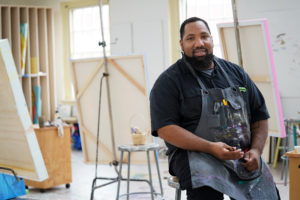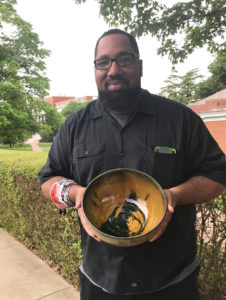Kendrick Keener was in third grade when his career path was illuminated. He and his fellow students had created placemats featuring leaves they had collected.
“My teacher made a really big deal about my artwork,” said Keener, whose placemat earned a front and center spot on the bulletin board. “She saw that even at that age, I understood the principles of design.”

That kind of praise makes all the difference in a child’s life, Keener said. He has dyslexia and recognizes that he wouldn’t be where he is today – earning both a master’s degree in pre-K-12 visual arts education and the Outstanding Education Student Award from the University of Mary Washington – without the support of educators. Now, he inspires his own students at the Fairfax County juvenile detention center where he’s worked for 13 years, the past three as a visual arts teacher.
“It’s important for these kids to have someone who cares,” Keener said. “The impact that a good teacher can have on a child is amazing.”
He should know. Keener said his teachers have had a profound influence on him, including the professor from the Maryland university where he received his undergraduate degree – who persuaded him to apply for a scholarship. When Keener hesitated, the professor reminded him he was just as good as anyone else and he should just try. Try, he did, and he won.
That same instructor suggested Keener would make a great art teacher someday. It stuck with him. After a decade as a school counselor, Keener decided to switch careers when his principal encouraged him to take the open art teacher position. He had always incorporated arts activities into the curriculum, even painting a 90-foot mural for the center. He began with a provisional license, but needed to complete his teaching licensure.
Keener enrolled in the master’s degree program in UMW’s College of Education (COE). It was convenient due to its evening class offerings, and the Stafford campus was close to the home he shares with his wife and four sons. It didn’t take long for him to fall in love with the university and the professors who guided him along the way.

“I had a wonderful experience at Mary Washington,” said Keener, who is especially thankful for his mentor and advisor, Teresa Coffman. The COE professor, who praised Keener’s “contagious passion for learning,” encouraged him when he felt stressed and unsure he could tackle the workload. “Dr. Coffman set me up to succeed. The program was rigorous, but she helped me keep up with the pace,” he said.
At UMW, Keener flourished. Inspired by his own children’s experiences with racism in the classroom, his research project, No Room for Racism, investigated best practices in cultural awareness training. It was met with rave reviews from his professors.
“Kendrick is a caring, supportive teacher who creates an inviting place for students to learn and explore their creativity,” said Associate Professor Jane Huffman, who taught Keener in several classes. “In projects and presentations, Kendrick shared the power of art as a teaching model for working with students facing personal challenges.”
Keener expects he’ll continue working in alternative education. “Kids in regular schools will always find a way to meet their goals. But I see so many students who don’t have dreams and that’s dangerous.”

Most of his students haven’t taken art since elementary school, so Keener made it his own personal mission to get every student invested in their artwork. He reminds them that they don’t need to draw well, but they should take pride in their work and explain what it means to them.
He takes inspiration from the words of Jean-Michel Basquiat, who elevated graffiti art from the streets to the walls of museums and galleries. On Keener’s forearm is a tattoo of the late artist’s crown motif and the quote, “If you can’t stop thinking about it, don’t stop working for it.”
Keener encourages his students not just to create, but to think and problem-solve creatively through lessons that speak to them. He observed that shoe culture is important to the teens, so one of his most popular projects has the students designing their own athletic shoes. They choose a specific audience to target and tell a story through the color palettes they’ve chosen.
Todd Bell, a math teacher at the detention center said Keener’s classroom is one of the only places where students can let down all their defenses and express themselves without judgment. “His ability to reach our children is built on trust, respect and a genuine interest in hearing what the kids have to say, even when they don’t know how to say it.”
The challenges are overwhelming – teens often make great strides in the classroom, but it’s difficult helping them once they leave the center – but Keener cannot imagine a more rewarding job than his. As a black male teacher, he hopes he can make even more of a difference because he and his students have shared similar life experiences.
“Anytime you see someone like you, you see possibilities. I was like them, but I had someone who held me accountable. I had people who believed in me.”





